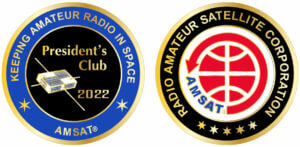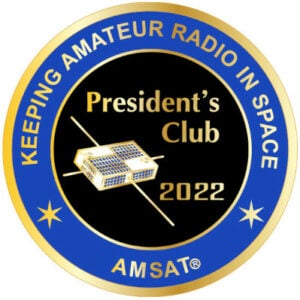The AMSAT News Service bulletins are a free, weekly news and information service of AMSAT, The Radio Amateur Satellite Corporation. ANS publishes news related to Amateur Radio in Space including reports on the activities of a worldwide group of Amateur Radio operators who share an active interest in designing, building, launching and communicating through analog and digital Amateur Radio satellites.
The news feed on http://www.amsat.org publishes news of Amateur Radio in Space as soon as our volunteers can post it.
Please send any amateur satellite news or reports to: ans-editor [at] amsat.org
You can sign up for free e-mail delivery of the AMSAT News Service Bulletins via the ANS List; to join this list see: https://mailman.amsat.org/postorius/lists/ans.amsat.org/
In this edition:
- The QO-100 AMSAT-UK/BATC North American Challenge
- Falconsat-3 Status is altered due to battery issues
- GreenCube Digipeater Successes Grow
- VUCC Satellite Standing November 1, 2022
- ARISS News
- Upcoming Satellite Operations
- Changes to AMSAT-NA TLE Distribution for November 3, 2022
- Hamfests, Conventions, Maker Faires, and Other Events
- Satellite Shorts From All Over
ANS-310 AMSAT News Service Weekly Bulletins
To: All RADIO AMATEURS
From: Radio Amateur Satellite Corporation
712 H Street NE, Suite 1653
Washington, DC 20002
DATE 2022 November 6
The QO-100 AMSAT-UK/BATC North American Challenge
AMSAT-UK and the British Amateur Television Club (BATC) announced a new amateur radio satellite service challenge, The QO-100 AMSAT-UK/BATC North American Challenge, during the AMSAT-UK International Space Colloquium in Milton Keynes, U.K. on October 8, 2022.
The QO-100 AMSAT-UK/BATC North American Challenge will recognize the first amateur radio station to successfully achieve a two-way QSO via QO-100 narrow band transponder while operating from North America, the first amateur radio station to achieve 100 QSOs via QO-100 narrow band transponder while operating from North America, and the first amateur radio station to achieve a successful two-way DATV QSO via QO-100 wide band transponder while operating from North America. In addition, subsequent operations from North America will also be eligible to apply for a special certificate.
The likely operating location from North America would be from St. Johns, Newfoundland, maidenhead grid square GN37qm (Lat/Long 47. 5204, -52.6262), which has a calculated viewing angle of -0.9 degrees elevation. Being below the horizon, it is expected that tropospheric ducting will be required for the first few miles, as demonstrated by Farid Farhan, YC1HVZ/P, during a recent QO-100 expedition in Indonesia, where he successfully operated through the QO-100 narrow band transponder from OI42de at -1.2 degrees elevation.
Detail of test being planned, general questions, and claims for trophies and certificates should be submitted to [email protected].
Es’hail-2 / AMSAT Phase 4-A / Qatar-OSCAR 100, a joint project by the Qatar Satellite Company (Es’hailSat), the Qatar Amateur Radio Society (QARS) and AMSAT Deutschland (AMSAT-DL), is the first geostationary amateur radio transponder and links radio amateurs from Brazil to Thailand.
Es’hail-2/QO-100 carries two “Phase 4” amateur radio transponders operating in the 2400 MHz and 10450 MHz bands. A 500 kHz bandwidth linear transponder intended for conventional analogue operations and an 8 MHz bandwidth transponder for experimental digital modulation schemes and DVB amateur television.
Graham has set up a webpage on the AMSAT-UK website: https://bit.ly/3DR4qTU
There is also a Youtube video on the AMSAT-UK channel: Direct link is https://bit.ly/3TUpXkv
[ANS thanks Graham Shirville, G3VZV and Robert Bankston, KE4AL AMSAT President for the above information]
Falconsat-3 Status is Altered Due to Battery Issues
Mark Hammond writes: “Telemetry suggests that one cell is very weak, therefore continuous 24/7/365 operations are no longer possible. In support of users around the world and the AMSAT PACSAT team (which is currently planning a PACSAT cubesat!), I will plan to try to run Falconsat-3 for about 24 hours each weekend, with specifics dependent upon the time of day it’s overhead, work, and recreation! The orbit precesses about 30 mins every day, so the time of day for usable passes cycles. But basically a 24 hour uptime every weekend. There’s a pass around 1222UTC today 29 Oct 202, and I’ll turn it ON with battery management OFF, hoping for about 24 hours of operations. This will continue as long as we reasonably can. Reentry is estimated to be in April 2022.
My best advice is to follow me on Twitter! It’s easy to post when I turn it ON/OFF, so lately that’s been my preferred method of sharing the information.
Also, please update your keps at least once per week, maybe more often. It appears to change enough to warrant this for people using tracking/high gain directional antennas. Here is the TLE source I’m using now: http://www.amsat.org/amsat/ftp/keps/current/daily.all
Hope this schedule works for users and the PACSAT team! Scheduled operations seem lke the most beneficial plan for now.”
[ANS thanks Mark L. Hammond [N8MH], AMSAT Director and Assistant VP – Operations for the above information.]
+=+=+=+=+=+=+=+=+=+=+=+=+=+=+=+=+=+=+=+=+=+=+=+=+=+=+=+=+=+=+=+=+=+=+

The 2022 AMSAT President’s Club coins have arrived!
To commemorate the 50th anniversary of its launch on
October 15, 1972, this year’s coin features
an image of AMSAT-OSCAR 6.
Join the AMSAT President’s Club today and help
Keep Amateur Radio in Space!
https://www.amsat.org/join-the-amsat-presidents-club/
+=+=+=+=+=+=+=+=+=+=+=+=+=+=+=+=+=+=+=+=+=+=+=+=+=+=+=+=+=+=+=+=+=+=+
GreenCube Digipeater Successes Grow
Doug Papay, K8DP, and Scott Chapman, K4KDR were the first to make a complete contact through the GreenCube digipeater. Doug has be journalling the growing list of stations that have sucessfully digipeated a packet through the Sapienza Space Systems and Space Surveillance Laboratory (S5Lab)/AMSAT-IT 3U research satellite.
Doug posts on Twitter that Steve Greene, KS1G, has also completed a contact. Drew Glasbrenner, KO4MA, Yoshihisa Hattori, JO1LVZ, Juan Antonio Fernandez Montana, EA4CYQ, Nader Omer, ST2NH, Jose Elias Diaz Rodriguez, EB1AO, Davis Romero, EA4SG, and Jean Marc Momple, 3B8DU (added by editor) all were successfully digipeated by the MEO satellite. Congratulations to all and all that follow! More completed contacts will no doubt be reported soon.
[ANS thanks AMSAT Doug Papay, K8DP for the above information.]
+=+=+=+=+=+=+=+=+=+=+=+=+=+=+=+=+=+=+=+=+=+=+=+=+=+=+=+=+=+=+=+=+=+
Need new satellite antennas? Purchase Arrows, Alaskan Arrows,
and M2 LEO-Packs from the AMSAT Store. When you purchase through
AMSAT, a portion of the proceeds goes towards
Keeping Amateur Radio in Space.
https://amsat.org/product-category/hardware/
+=+=+=+=+=+=+=+=+=+=+=+=+=+=+=+=+=+=+=+=+=+=+=+=+=+=+=+=+=+=+=+=+=+
VUCC Satellite Standing November 01, 2022
VUCC Satellite Award/Endorsement Change Summary for October 02, 2022 to November 01, 2022.
[table “84” not found /]Congratulations to the new VUCC holders.
OZ9AAR is first VUCC Satellite holder from Denmark and 1st from JO45
[ANS thanks Jon Goering, N7AZ, AMSAT VUCC Manager for the above information.]
+=+=+=+=+=+=+=+=+=+=+=+=+=+=+=+=+=+=+=+=+=+=+=+=+=+=+=+=+=+=+=+=+=+
Want to fly the colors on your own grid expedition?
Get your AMSAT car flag and other neat stuff
from our Zazzle store!
25% of the purchase price of each product goes
towards Keeping Amateur Radio in Space
https://www.zazzle.com/amsat_gear
+=+=+=+=+=+=+=+=+=+=+=+=+=+=+=+=+=+=+=+=+=+=+=+=+=+=+=+=+=+=+=+=+=+
ARISS NEWS
Amateurs and others around the world may listen in on contacts between amateurs operating in schools and allowing students to interact with astronauts and cosmonauts aboard the International Space Station. The downlink frequency on which to listen is 145.800 MHz worldwide.
Ural State University, Yekaterinburg, Russia, direct via TBD. The ISS callsign is presently scheduled to be RSØISS. The downlink frequency is presently scheduled to be 145.800 MHz. The scheduled crewmember is TBD. Contact is go for Sun 2022-11-20 TBD UTC
The crossband repeater continues to be active. If any crewmember is so inclined, all they have to do is pick up the microphone, raise the volume up, and talk on the crossband repeater. So give a listen, you just never know.
The latest information on the operation mode can be found at https://www.ariss.org/current-status-of-iss-stations.html
The latest list of frequencies in use can be found at https://www.ariss.org/contact-the-iss.html
[ANS thanks Charlie Sufana, AJ9N, one of the ARISS operation team mentors and NASA News for the above information]
+=+=+=+=+=+=+=+=+=+=+=+=+=+=+=+=+=+=+=+=+=+=+=+=+=+=+=+=+=+=+=+=+=+
AMSAT, along with our ARISS partners, is developing an Amateur
Radio package, including two-way communication capability, to
be carried on-board Gateway in lunar orbit.
Support AMSAT’s projects today at https://www.amsat.org/donate/
+=+=+=+=+=+=+=+=+=+=+=+=+=+=+=+=+=+=+=+=+=+=+=+=+=+=+=+=+=+=+=+=+=+
Upcoming Satellite Operations
Quick Hits:
KX9X Will be in EM47 with Ward N0AX the weekend of November 19 for the @arrl Phone Sweeptakes. I’ll take some satellite gear and do a few passes. Sats aren’t the priority this trip but will hand out the grid.
Major Roves:
Snow-bird rove from 11-02-2022 thru 11-22-2022-ish. Check Twitter for updates.
In travel order: OR grids: CN82 and DN02
NV grids: DN01, DN10, DN21, DN20, DM29 & 19, DM28 & 18, DM27, DM26.
AZ grids: DM36, DM46, DM45, DM35, DM44, DM34, DM33, DM32.
Email (QRZ) with desired grid in subj. line for updates. Wayne – W7WGC
[ANS thanks Paul Overn, KE0PBR, AMSAT rover page manager and AMSAT for the above information]
Changes to AMSAT-NA TLE Distribution for November 3, 2022
None announced this week.
[ANS thanks Ray Hoad, WA5QGD, AMSAT Orbital Elements Manager, for the above information]
Hamfests, Conventions, Maker Faires, and Other Events
AMSAT Ambassadors provide presentations, demonstrate communicating through amateur satellites, and host information tables at club meetings, hamfests, conventions, maker faires, and other events.
None presently scheduled.
[ANS thanks Paul Overn, KE0PBR, AMSAT Events Page Manager, for the above information]
Satellite Shorts From All Over
+ NASA’s MOXIE experiment on Perseverance has now generated ISRU oxygen successfully during many different times of the Martian day and year (paper), producing about 6g of oxygen per hour (similar to the production rate of a medium-sized tree). NASA life support design requirements specify 35 g of oxygen per hour for astronauts. [ANS thanks The Orbital Index for the above information.]
+ Under layers of dust, NASA’s Mars InSight lander is fading, but the first and only seismometer on Mars had one parting gift for humanity: on May 4th, a magnitude 4.7 marsquake, one of the largest detected on the red planet. Related: In Issue 189 we talked about InSight’s detection of meteor impacts on Mars—now we have another one, a magnitude 4 marsquake last December turns out to have been due to a significant impact, now spotted by MRO, which “excavated boulder-size chunks of ice buried closer to the Martian equator than ever found before.” [ANS thanks The Orbital Index for the above information.]
Join AMSAT today at https://launch.amsat.org/
In addition to regular membership, AMSAT offers membership to:
* Societies (a recognized group, clubs or organization).
* Primary and secondary school students are eligible for membership at one-half the standard yearly rate.
* Post-secondary school students enrolled in at least half time status shall be eligible for the student rate for a maximum of 6 post-secondary years in this status.
* Memberships are available for annual and lifetime terms.
Contact info [at] amsat.org for additional membership information.
73 and remember to help Keep Amateur Radio in Space!
This week’s ANS Editor, Jack Spitznagel, KD4IZ
kd4iz at arrl dot org

